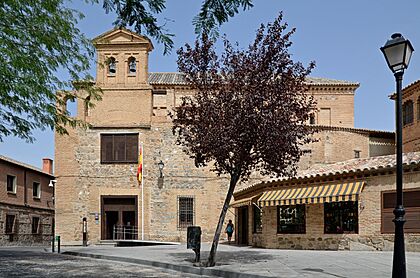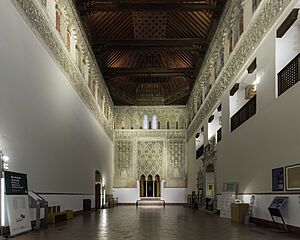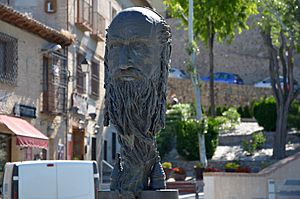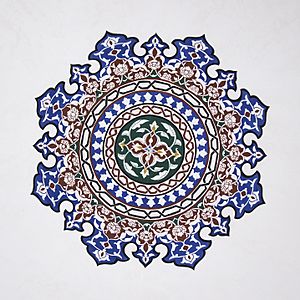Synagogue of El Tránsito facts for kids
Quick facts for kids Synagogue of El Tránsito |
|
|---|---|
|
Spanish: Sinagoga del Tránsito
|
|

Exterior of the former synagogue and former church, in 2012
|
|
| Religion | |
| Affiliation |
|
| Rite | Nusach Sefard |
| Ecclesiastical or organizational status | |
| Status |
|
| Location | |
| Location | Calle Samuel Levi, Toledo, Castilla-La Mancha |
| Country | Spain |
| Architecture | |
| Architect(s) | Don Meir (Mayr) Abdeil |
| Architectural type | Synagogue architecture |
| Architectural style | Mudéjar/Moorish |
| Founder | Samuel HaLevi Abulafia |
| Date established | c. 1350s (as a congregation) |
| Completed |
|
| Materials | Stone |
The Synagogue of El Tránsito (Spanish: Sinagoga del Tránsito) is also known as the Synagogue of Samuel ha-Levi. It is a historic building in Toledo, Castilla-La Mancha, that was once a Jewish synagogue.
It was built in 1357 in the Mudéjar or Moorish style. The synagogue was designed by a master builder named Don Meir (Mayr) Abdeil. It was part of the palace of Samuel HaLevi, who was a very important treasurer to King Peter of Castile. The building is located in the old Jewish quarter of Toledo. It is one of only three synagogues built by Jewish people under the rule of the Christian Kingdom of Castile that are still standing today.
After Jewish people were expelled from Spain in 1492, the building became a Catholic church. Later, in the early 1800s, it was used as military barracks during the Napoleonic Wars. Since 1910, it has been a Sephardic Jewish museum, officially called the Sephardic Museum.
The building is famous for its beautiful stucco decorations and its unique Mudéjar style. It also has a special gallery for women. It is now recognized as a monument of Spanish Cultural Heritage.
Contents
History of the Synagogue
Building the Synagogue
The synagogue was built around 1357. It was supported by Samuel HaLevi, who belonged to the Abulafia family. His family had served the ruling Castilian House of Burgundy for many years. They included important Jewish scholars and thinkers.
This synagogue was located inside Toledo's old Jewish quarter. It was connected to Samuel Abulafia's home by a gate. It was meant to be a private place of worship for him and his family. It also served as a center for Jewish religious learning, called a yeshiva.
Some historians believe that King Peter of Castile allowed the synagogue to be built as a thank you to Samuel for his work as the king's advisor and treasurer. The king might also have allowed it to make up for the unfair treatment of Jewish people in Toledo during the persecution of Jews during the Black Death in 1348.
During the 14th century, Spanish councils had made rules against building new synagogues. It is still debated why this synagogue was allowed. One idea is Samuel's close relationship with King Peter of Castile. Another is that it was built as a private home, which sometimes allowed people to get around the ban. It is also thought that the synagogue was built over an older one, which might have been a way to follow the rules.
Samuel eventually lost the king's favor. He was arrested in December 1360 on charges of corruption. He was put in prison in Seville and died after being tortured.
During the terrible Massacre of 1391 against Jewish people, the Jewish quarter of Toledo was attacked. However, the synagogue was saved from destruction.
From Synagogue to Church
After Jewish people were expelled from Spain in 1492, the synagogue was turned into a church. King Ferdinand and Queen Isabella of Spain gave it to the Order of Calatrava. This group changed the building into a church for a priory dedicated to Saint Benedict. It was during its time as a church that the building got the name "El Tránsito." This name refers to the Assumption of the Virgin Mary. In the 17th century, the church's name became Nuestra Señora del Tránsito. This name came from a painting inside the church by Juan Correa de Vivar, which showed the Transit of the Virgin.
Military Use and Museum
The synagogue was used as military headquarters during the Napoleonic Wars in the early 1800s.
In 1877, the building became a national monument. Around 1910, work began to turn the building into the Sephardi Museum, as it is known today. This project was started by the Vega-Inclan Foundation. In 1964, a royal order officially created the Museo Sefardi inside the Synagogue of Samuel ha-Levi. Four years later, in 1968, it was renamed the National Museum for Hispanic-Hebraic Art. The building is still a museum today and is in very good condition.
Restoring the Building
After being used as a church and then military barracks, the building went through several periods of restoration. The first major repairs started in 1879. This included cleaning and fixing the Torah ark and restoring many decorative screens. In 1884, a new architect, Arturo Mélida y Alinari, took over. He focused on the roof, the front of the building, and strengthening its structure.
The building fell into disrepair again before it became part of the El Greco Museum in 1911. At that time, a new large-scale restoration project began. Old scaffolding and partitions from the women's gallery were removed. The wooden church choir and parts of the inside were repaired. A library was added to the lower part of the gallery. This library has become an important center for studying Hebrew.
Architecture of El Tránsito
With the king's approval, Samuel built the synagogue in a way that went against rules. These rules usually required synagogues to be smaller and less decorated than churches. The main prayer hall is a rectangle, about 23 meters (75.5 feet) long and 9.5 meters (29.5 feet) wide. It has a very high ceiling, about 12 meters (40 feet) tall.
The hall features colorful stucco in the Nasrid style. It also has arches with many curves and a huge Mudéjar artesonado ceiling made of wood. Inside, there are Hebrew writings that praise the king and Samuel. There are also Arabic writings and quotes from Psalms. The building also mixes Christian elements, like muqarnas (a type of decorative vaulting) with family symbols and plant designs. These designs were common in Christian, Islamic, and Jewish buildings of that time. The haLevi family symbol is also part of the decoration.
Arabic writings surround the prayer room, mixed with flower patterns in the stucco. These writings are in a style called Kufic and include positive messages and praises of God, common in Islamic art. Along the prayer hall, there are large frames made of larch wood. These frames have colorful inlaid carvings, some made of ivory. The original floor was covered in mosaics, but only some parts of it remain. Many windows let light into the hall.
Women were separated from men during services. A second-floor gallery was set aside for them. This gallery is along the southern wall and has five wide openings looking down towards the Torah ark. This ark is called the hekhal by Sefardic Jews. The hekhal has a special design with three vertical panels. The middle panel has a pattern called sebka, and there are decorative edges with plant and garden designs.
The architecture of El Tránsito influenced other synagogues built in the 14th century. For example, the Córdoba Synagogue has a similar three-panel hekhal design and Mudéjar architecture.
Unlike its highly decorated inside, the synagogue's outside was built simply with brick and stone. The outer walls are plain, with a special window called an aljima (two horseshoe arches) above the entrance door. This made the synagogue look like a normal building from the outside, except for its tall roof, which made it stand out slightly from nearby buildings.
The eastern wall has the most decoration. It is made of cedar wood and divided into six parts. The top half is decorated with arches that have seven curves. The center part has patterns called arabesques. It is believed that Samuel brought the wood from Lebanon to copy King Solomon's temple.
Mudéjar Style
The El Tránsito Synagogue is a great example of the mudéjar style of art and architecture from medieval Spain. This style was inspired by Islamic art. The front of the synagogue is a prime example of Mudéjar architecture in al-Andalus. It shows the high social status, power, and influence of Samuel ha-Levi. Ha-Levi often visited the Nasrid dynasty's court in Granada at the palace of the Alhambra. He likely spoke Arabic. Because of this, people believe he was inspired by the Alhambra's architecture and copied it for the synagogue.
Around the same time the synagogue and the Alhambra were built, King Peter of Castile restored the Alcazar of Sevilla. This was an old fortress with Nasrid and Mudéjar designs. Muhammad V of Granada and Peter of Castile were sometimes allies. They are thought to have shared their architects and artists to build very grand palaces. As the king's treasurer, ha-Levi traveled between Seville, Granada, and Toledo while the synagogue was being built. He also talked with the king's builders and architects about construction costs. So, he likely benefited from the same talented people and design ideas.
The mix of Islamic architecture and the Castilian coat of arms is important. It shows that Ha-Levi worked with the main religions of the time. The fact that Samuel was trusted to use the Castile seal shows his power and how much King Peter of Castile relied on him.
Hebrew and Arabic Writings
The Arabic writings in the Synagogue are decorative and can be read, but they are not from the Quran. They are placed away from the Eastern wall (the main focus of the Synagogue) and higher up. They were also meant as a good sign of different faiths getting along. For example, one of these writings says: Bi'l ni'mah wa-bi'l quwah wa bo'l karamah, which means "by (or in) grace, power, magnanimity (or, alternatively, generosity or happiness), salvation."
The Hebrew writings, however, come from Psalms. One mentions Ariel, which refers to Jerusalem. The Hebrew writings around the coat of arms say:
"Let us sing of the Lord's kindness and His works, for He has blessed us and done great things. He has given us leaders to save His people from enemies and those who oppress them.
There is no king in Israel, yet He has not left us without a rescuer.
He is a strong tower, and since the exile of Ariel, no one like him has risen in Israel.
For His Name, glory, and praise,
His name is known in Israel since He lived in His land and stood before kings.
To him who stands in the gap
And seeks the good of his people,
Head of the exile of Ariel,
The chosen leader.
The crown and great man of the Jews,
People come to him from all over the Earth.
He is the ruler of the land,
The great tamarisk,
A fortress of strength and greatness.
He rose in greatness according to his praise, and great and holy
Will he be called.
The strong pillar on which the House of the Levite (Halevi) and the House of Israel are built.
And who can count his praises?
His good qualities and his deeds,
Who can tell?
And who will fully praise him?
A symbol of rule, a sign of dignity,
He stands at the head of the order,
Honored among the honored Levites of God, Samuel Ha-Levy,
The man raised high.
May God be with him and help him succeed.
He found grace and
Favor in the eyes of the great eagle, the great one, the man of war and the man of the middle.
Whose power has been felt by all peoples,
Great is his name among the nations.
The great King, our protector and our lord, King Don Pedro,
May God help him,
And increase His power and glory,
And guard him like a shepherd guards his flock.
The King has made him great and honored him,
And raised his throne above all the ministers.
And without him, no one shall act.
And the nobles bowed to him with their faces to the ground.
He is known throughout the land among
The peoples heard.
His fame has been heard through all the kingdoms,
And he has been a savior to Israel."
Also on the Eastern wall, above the blind arches, there is a special plaque dedicated to Samuel HaLevi. Because it is old and damaged, the exact date is hard to read. However, experts can figure out the year by using Hebrew words that also act as numbers. On the plaque, the Hebrew letters טוב ליהודים add up to 5122 in the Hebrew calendar. This is the same as 1357 in our calendar.
The honored and good prince of princes of Levi…has done great things by building a house of prayer for the Lord God of Israel… and he started building this house in the year (1357)
Below the Coat of arms of Castile and León is another Hebrew writing. It expresses how beautiful the synagogue is. It mentions Bezalel, a person from the Bible chosen to build the Tabernacle. This compares HaLevi to Bezalel, suggesting he was also chosen for a great building project:
And its courtyards for those who pay attention to the perfect Law/and its seating for those who sit in His shadow/so beautiful that those who see it must almost say: The design of this [temple]/ is like the design of the work by Bezalel/Walk, nations, and enter through its doors/And look for God, because it is like the house of God, like Bethel"
In the prayer room, just below the ceiling on top of the four walls, we find the following writing:
Some experts believe these writings also refer to another famous Samuel, a Levite named Samuel ibn Naghrillah (993-1056). He was an important Jewish leader in the Middle Ages. Both Samuels were proud of their family history as Levites.
Symbolic Designs
The starry sky design on the upper part of the synagogue walls represents heaven. Meanwhile, the floor, which has plant patterns, stands for the Earth. This is important because it shows the separation of heaven and Earth and its connection to Jerusalem. According to Jewish belief, Jerusalem is the highest place on Earth, acting as a link between heaven and Earth. This makes it the place closest to heaven.
In the synagogue, there is a stucco carving near the top of the wall and also lower down that represents Jerusalem. This symbolic reference to Jerusalem comes from the Genesis creation narrative. The way the stucco designs are placed with the writings is similar to the Alhambra. Samuel wanted people to "read" the architecture and art like a book, just as they would in palaces and mosques in al-Andalus.
Gallery
See also
 In Spanish: Sinagoga del Tránsito para niños
In Spanish: Sinagoga del Tránsito para niños
- History of the Jews in Spain
- List of synagogues in Spain












